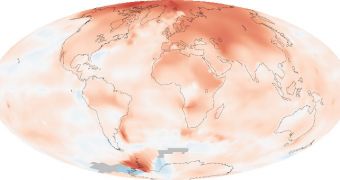Finding life on another planet would undoubtedly represent the start of a new era for our civilization. Regardless if it's just a simple microorganism, or a highly-advanced creature, an alien would change the way we look at the Universe, and would force many to change their conceptions about how the Cosmos works. But in order for that to happen, we have to identify other lifeforms, living, or that lived, on different worlds, and this has proven extremely difficult to do. Now, scientists propose using our own climate as a reference point in conducting our searches, Space reports.
While greenhouse gases (GHG) today are very harmful to Earth, its ecosystems, and our species, things have not always been the same. According to paleoclimatologists, who spend their time studying the planet's climate past, it could be that global warming is what allowed life to appear, emerge and develop here in the first place. At the dawn of the solar system, the Sun was a lot colder than it is today, and Earth must have been considerably less warm as well. It could then be that heat trapped in the thick atmosphere surrounding our planet may have played a crucial role in keeping temperatures high enough to allow for the earliest lifeforms to thrive.
By studying the evolution of Earth's early climate, researchers say that we could get a deeper understanding of similar phenomena currently going on in other places in the solar system, as well as on exoplanets and exomoons. “The problem was, the Sun was fainter and the energy input to the atmosphere was reduced. We need to explain how, despite a fainter Sun, the surface could be warm enough to host liquid water,” explains Technische Universitat Berlin atmospheric chemist J. Lee Grenfell. He is the lead author of a new study detailing the idea, which appears in the latest issue of the esteemed scientific journal Astrobiology.
The investigator used the information he had on Earth's past climate to devise a computer model that accounts for available heat and atmospheric variations soon after the planet appeared, and then cross-referenced this with other planets. “As our knowledge deepens in future, we will extend our models to include, for example, interactions between the atmosphere and oceans and geological processes. The Earth is the only example we have where life has changed the atmosphere of the planet. If the Earth had evolved without life, or if life was switched off, the climate would be very different,” the expert believes.
“The biologists tell us that certainly life as we know it on Earth needs liquid water to establish itself to thrive, to reproduce. Liquid water requires certain climate conditions – and habitats for life on Earth occur over a large temperature range, approximately between 0 degrees Celsius [32 degrees Fahrenheit] up to maybe 120 degrees Celsius [248 degrees Fahrenheit]. Different types of microorganisms adapt to their particular niche temperature over this wide range. Complex life can survive and thrive from about 0 to 30 degrees Celsius,” he concludes.

 14 DAY TRIAL //
14 DAY TRIAL //